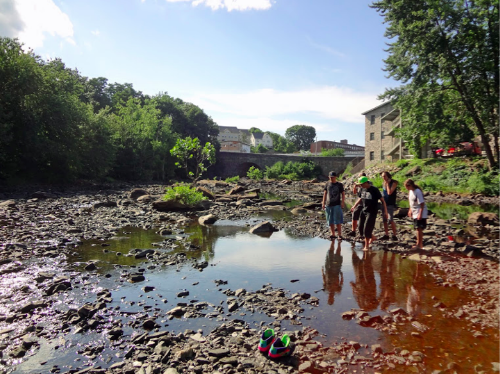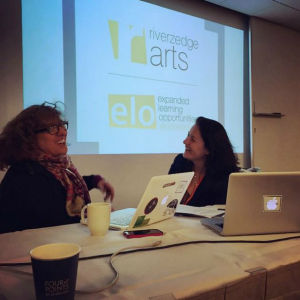In Woonsocket, Rhode Island, the Blackstone River runs deep. If you visit the city’s downtown, you can’t help but drive alongside the waterway or crisscross it via a bridge or two. It’s everywhere. But as with anything you see on a daily basis, you might eventually forget the river is there once you’ve spent a bit of time in the city.
Like the Woonsocket youth who hang out on the river’s banks, however, there’s more to the river than meets the eye. It has highs and lows, and benefits from the steadfast, behind-the-scenes care of local leaders who ensure its vitality well into the future.
For nonprofit educators Rebekah Greenwald Speck, Karen Barbosa, and Liz Holohan, this kind of stewardship is their daily work. As their students’ lives ebb and flow, often due to forces they cannot control, they have gotten used to “drop[ing] everything” to provide whatever learning and support their individual students need. In fact, they’ve worked with the Woonsocket public school district to build an entire educational program around this idea of personalization.

At Riverzedge Arts, the team has developed an innovative expanded learning opportunity (ELO) program, ELO Woonsocket, which helps Woonsocket high school students envision and work toward positive futures, earning credits while simultaneously engaging in self-selected, high-interest projects. Through the team’s efforts, Woonsocket students are not only earning enough credits to graduate high school, but also developing the skills and mindsets that will propel these youth into productive, passionate lives after graduation. And in a city known for generational poverty, declining graduation rates, and a struggling post-industrial economy, that’s a pretty bold reversal.
But ELO Woonsocket’s success hasn’t come without a steep learning curve and lots of trial and error for the Riverzedge Arts staff. What started out in 2005 as “good idea”—allowing students to gain hands-on experience in out-of-school environments—only became real four years later when a struggling and disengaged young man was connected with Riverzedge because of the elaborate designs he was carving into his desk at school. Since this initial test case, the ELO program has slowly blossomed into a vision for a long-term, systematic way to stem the tide of unemployment and brighten prospects for Woonsocket’s youth. (And David, the ELO program’s first student, is currently completing a post-secondary degree in landscape architecture.)
During their March 17 presentation at the New England Secondary School Consortium’s High School Redesign in Action Conference (#NESSC16), Greenwald and her colleagues shared lessons learned during their ten years of experience in designing and implementing the Woonsocket ELO program. Their hope is to provide practical guidance for educators and communities who are interested in beginning similar initiatives.
For Riverzedge, a critical lesson has been the importance of identifying “a coalition of the willing,” especially as the program is getting started. In Woonsocket, Riverzedge collaborates with a team of public educators, community organizations, local universities, and industry professionals who work together to ensure that every student in the program has a personalized, standards-based opportunity to earn credit in a real-world setting. The ELO Woonsocket program, also called “Credit Creative,” hinges on partnerships with about thirty local organizations—from Woonsocket Public Schools, to Brown University, the Rhode Island School of Design, and Roger Williams University, to the Urban Design League, to the local police department, skateboard shop, health centers, Rotary, and social service agencies.
With support from this team of adults, Woonsocket ELO students engage an individualized, credit-bearing course of study that enables them to explore an area of interest—such as pharmacy, sports psychology, studio design, firefighting, or filming. Each student refines and researches a guiding question, and develops a final product that a Woonsocket educator assesses against the pre-determined learning standards. All told, the program has served approximately 115 students this year and has plans to continue growing.
Now, in an effort to help others jumpstart their own partnerships and ELO programming, Greenwald, Barbosa, and Holohan are taking their story to the streets.

In their NESSC High School Redesign in Action conference presentation, the trio introduced several resources that will support school districts and community-based organizations in launching expanded learning opportunities. Their Credit Creative Road Map and Tool Kit are licensed through Creative Commons and will be available in July 2016 on the Riverzedge Arts website. The toolkit contains resources that have been fine-tuned through the Riverzedge ELO program, including:
- guidance for leaders
- suggested ELO activities
- checklists for leaders, administrators, and policymakers
- informational packets for program leads, district administrators, industry mentors, and students
- standards-based rubrics
- sample forms
Likewise, the roadmap lays out a recommended sequence of steps for the design, implementation, and evaluation of any ELO—from the helping shape a student’s initial idea for an ELO, to securing guidance from an industry mentor and consultation with a teacher, to assessing the final product and adding the credit to the student transcript.
In addition to previewing these resources, Greenwald, Barbosa, and Holohan offered advice to participants interested in starting a local ELO effort, such as bringing together students, teachers, district leaders, and community partners for strategic conversations and a deliberate, small-scale pilot. Holohan suggested that before diving in to an ELO effort, educators should take the time to identify the specific individuals who could get the program off on the right foot. The presenters also encouraged participants to get comfortable with “failing forward” by constantly tracking, assessing, and refining the initiative.
Perhaps most importantly, the Riverzedge Arts team emphasized that leaders should consider the circumstances of their schools and community as they put the tools into use. “Everything that’s included in the toolkit are just pieces of paper; they can’t alone deliver a successful program,” Barbosa noted. Similarly, leaders were encouraged to adapt the roadmap to suit their unique needs. Greenwald added that “individualized learning requires flexibility and a situational response—depending on whether the river is high or low.”
To learn more about the process of creating an ELO in Woonsocket, check out this video:
